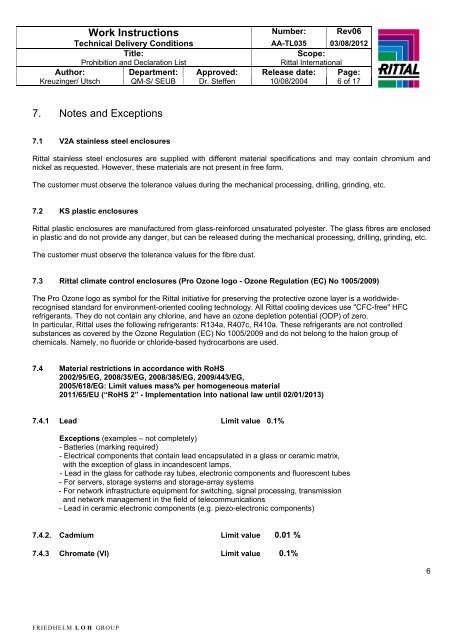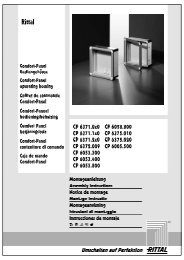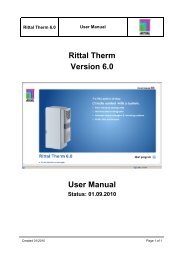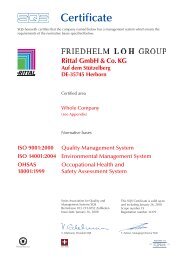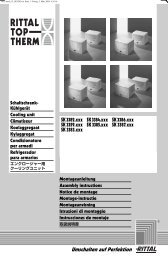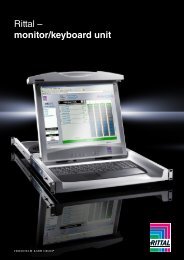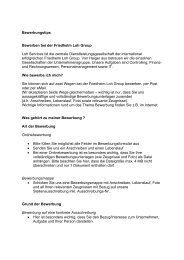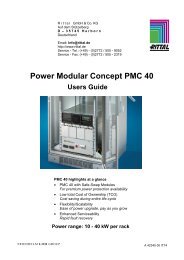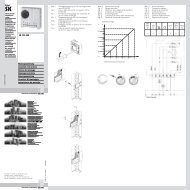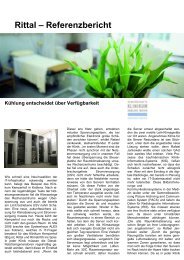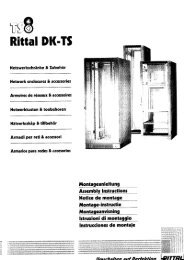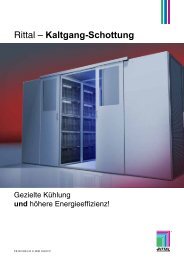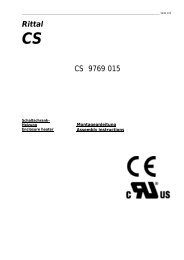Prohibition and Declaration List
Prohibition and Declaration List
Prohibition and Declaration List
You also want an ePaper? Increase the reach of your titles
YUMPU automatically turns print PDFs into web optimized ePapers that Google loves.
Work Instructions Number: Rev06<br />
Technical Delivery Conditions AA-TL035 03/08/2012<br />
Title: Scope:<br />
<strong>Prohibition</strong> <strong>and</strong> <strong>Declaration</strong> <strong>List</strong> Rittal International<br />
Author: Department: Approved: Release date: Page:<br />
Kreuzinger/ Utsch QM-S/ SEUB Dr. Steffen 10/08/2004 6 of 17<br />
7. Notes <strong>and</strong> Exceptions<br />
7.1 V2A stainless steel enclosures<br />
Rittal stainless steel enclosures are supplied with different material specifications <strong>and</strong> may contain chromium <strong>and</strong><br />
nickel as requested. However, these materials are not present in free form.<br />
The customer must observe the tolerance values during the mechanical processing, drilling, grinding, etc.<br />
7.2 KS plastic enclosures<br />
Rittal plastic enclosures are manufactured from glass-reinforced unsaturated polyester. The glass fibres are enclosed<br />
in plastic <strong>and</strong> do not provide any danger, but can be released during the mechanical processing, drilling, grinding, etc.<br />
The customer must observe the tolerance values for the fibre dust.<br />
7.3 Rittal climate control enclosures (Pro Ozone logo - Ozone Regulation (EC) No 1005/2009)<br />
The Pro Ozone logo as symbol for the Rittal initiative for preserving the protective ozone layer is a worldwiderecognised<br />
st<strong>and</strong>ard for environment-oriented cooling technology. All Rittal cooling devices use "CFC-free" HFC<br />
refrigerants. They do not contain any chlorine, <strong>and</strong> have an ozone depletion potential (ODP) of zero.<br />
In particular, Rittal uses the following refrigerants: R134a, R407c, R410a. These refrigerants are not controlled<br />
substances as covered by the Ozone Regulation (EC) No 1005/2009 <strong>and</strong> do not belong to the halon group of<br />
chemicals. Namely, no fluoride or chloride-based hydrocarbons are used.<br />
7.4 Material restrictions in accordance with RoHS<br />
2002/95/EG, 2008/35/EG, 2008/385/EG, 2009/443/EG,<br />
2005/618/EG: Limit values mass% per homogeneous material<br />
2011/65/EU (“RoHS 2” - Implementation into national law until 02/01/2013)<br />
7.4.1 Lead Limit value 0.1%<br />
Exceptions (examples – not completely)<br />
- Batteries (marking required)<br />
- Electrical components that contain lead encapsulated in a glass or ceramic matrix,<br />
with the exception of glass in inc<strong>and</strong>escent lamps.<br />
- Lead in the glass for cathode ray tubes, electronic components <strong>and</strong> fluorescent tubes<br />
- For servers, storage systems <strong>and</strong> storage-array systems<br />
- For network infrastructure equipment for switching, signal processing, transmission<br />
<strong>and</strong> network management in the field of telecommunications<br />
- Lead in ceramic electronic components (e.g. piezo-electronic components)<br />
7.4.2. Cadmium Limit value 0.01 %<br />
7.4.3 Chromate (VI) Limit value 0.1%<br />
FRIEDHELM LOH GROUP<br />
6


